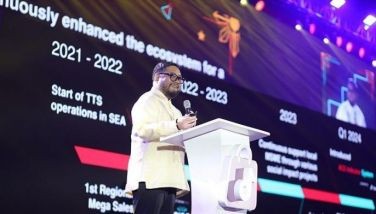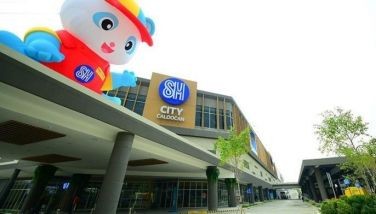Rising above water through crab culture
August 8, 2004 | 12:00am
The following is not so much a story of a project earning an income as it is a story of collaboration among a cooperative, a non-government organization, local government units, and the Bureau of Fisheries and Aquatic Resources (BFAR).
Thought to be "dying," the Lintugop Farmers’ and Fishermen’s Multi-Purpose Cooperative (LFFMPC) of Aurora, Zamboanga del Sur, is one of eight cooperatives revived by BFAR’S Fisheries Resource Management Project (FRMP). The FRMP is a six-year project funded by the Asian Development Bank (ADB) and Japan Bank for International Cooperation (JBIC). The LFFMPC was initiated by JEP Consultants at Trainers Alternative for Resource (JEP-ATRE), an NGO contracted by FRMP in Region 9.
Composed mainly of fisherfolk, housewives, fish vendors, crab gatherers, fish brokers and small fishpond operators, LFFMC was registered with the Cooperative Development Authority in October 2000 with 112 members. It almost folded up, however, when the JEP-ATRE’s contract with FRMP expired in 2001. The NGO’s contract was later renewed after two years.
By then, many of the co-op members have become demoralized and that the number of active members had gone down to 52.
Local folks said they thought FRMP was one of those "now-you-see-it, now-you-don’t" government initiatives like the ones that they experienced in the past. "Binitin lang kami," some of the members lamented in their dialect when they were asked about past initiatives. Many feared that they would just be "orphaned" again or, worse, be used as source of information for project proposals that are never approved nor implemented.
Thus, when FRMP’s mangrove crab culture in pond project was started by LFFMPC, only 22 among the active members joined in.
What then convinced the officers and members to keep their cooperative going given the negative experiences they had in the past? Board member Jenneth Cabonilla and treasurer Josie de Mesa said the assistance in the form of supplies and materials, and the daily presence of a community development worker provided by FRMP were key factors in motivating them to strengthen their coop.
The strong determination of the officers especially co-op chairman Manuel "Boy" Vicera who also acts as project manager is also a big moral booster, according to Cabonilla.
Nipa shingle sewer Roberta Salavaria has a rather personal motivation: "I enjoy the collective work particularly during the hands-on training and the regular meetings wherein we get the chance to talk not only about our project but also about what’s going on with our lives, our children, and the latest news about our favorite movie stars." Some members also cited the good management style of Vicera, a commerce graduate, whose skills in accounting proved handy.
LFFMPC is now on the verge of fully being revitalized. Its business-oriented leadership has attracted new members. Resources-wise, LFFMPC is also a bit richer as evidenced by an increase in their bank account.
The mangrove crab culture in pond project was introduced in Lintugop through FRMP’s Accelerated Capability Enhancement of Small Scale Entrepreneurship (ACCESS). Through this initiative, LFFMPC members were given training and were provided with needed instructional materials on the technology of mangrove crab culture. Introduced as an alternative livelihood for fisherfolk who are dependent on the degraded resources of Panguil Bay, the project can be found at the center of the 750-hectare barangay whose population stood at 3,217 in year 2000.
Lintugop is one of the five coastal barangays of Aurora, Zamboanga del Sur covered by Panguil Bay. The town is situated on a plateau rising 1,000 feet above sea level. It is classified as a third class municipality in terms of LGU income classification.
In November 2003, the LFFMPC finished with great success its first cycle of implementation. The project was started on a 0.7-hectare pond stocked with 3,784 pieces, or 312.82 kilos of thin crabs and crablets. Stocking was done using one male for every five females. Stocking rate was planned at one crablet per square meter. However, due to lack of seedlings of the same size and classification, stocks were not uniform.
Harvesting was done continuously according to orders from costumers.
Aside from the crablets, shrimp, tilapia, mudfish and gobies would enter the pond through the gate, providing additional income for the co-op. Thus, for the second cycle of operation, they decided to stock tilapia and prawn as secondary stocks.
"Aside from mangrove crabs, tilapia and prawn were also considered as secondary stocks in the fishpond. It did not in any way affect the production of mangrove crab, instead tilapia and prawn added to our income" Lintugop barangay captain Roger Defita said.
The initial harvest provided the group with a gross income of more than P50,000 and net income of more than P5,000. Aside from the economic returns, a positive relationship among the project beneficiaries developed because of the bonding that resulted from the hands-on training provided them. Through this undertaking, community members observed that their relationship was strengthened.
What have the coop members learned from the project? What can they advise those wishing to venture into a similar undertaking?
"There should be a written policies and/or agreement in all aspects of a livelihood project especially if people and monies are involved," Vicera said. He cited in particular their problem with the caretaker who demanded that he be paid for the labor he rendered during the preparatory stage of the project when he was not yet hired. The caretaker also asked for a share from the "bonus income" from the crabs, tilapia and gobies. This financial demand has been a source of worry for the co-op’s board because the project’s income is barely enough to "pay back" the cost of materials that FRMP provided them (and which will be used again for the project’s expansion).
Vicera also said that they learned that crabs in pond are very attractive to thieves, thus requiring a 24-hour watch. Hence, there should be a provision for the salary or honoraria for a guard or caretaker. A guardhouse that also serves as a temporary shelter for the couple-members who have been hired to watch the pond on a 24-hour basis was constructed to address this problem.
After a full year implementation, the project provided substantial earnings for all the members of the coop. They hope that their learnings will be valuable lessons as well for those areas, families and people’s organizations interested to venture into mangrove crab culture.
Thought to be "dying," the Lintugop Farmers’ and Fishermen’s Multi-Purpose Cooperative (LFFMPC) of Aurora, Zamboanga del Sur, is one of eight cooperatives revived by BFAR’S Fisheries Resource Management Project (FRMP). The FRMP is a six-year project funded by the Asian Development Bank (ADB) and Japan Bank for International Cooperation (JBIC). The LFFMPC was initiated by JEP Consultants at Trainers Alternative for Resource (JEP-ATRE), an NGO contracted by FRMP in Region 9.
Composed mainly of fisherfolk, housewives, fish vendors, crab gatherers, fish brokers and small fishpond operators, LFFMC was registered with the Cooperative Development Authority in October 2000 with 112 members. It almost folded up, however, when the JEP-ATRE’s contract with FRMP expired in 2001. The NGO’s contract was later renewed after two years.
By then, many of the co-op members have become demoralized and that the number of active members had gone down to 52.
Local folks said they thought FRMP was one of those "now-you-see-it, now-you-don’t" government initiatives like the ones that they experienced in the past. "Binitin lang kami," some of the members lamented in their dialect when they were asked about past initiatives. Many feared that they would just be "orphaned" again or, worse, be used as source of information for project proposals that are never approved nor implemented.
Thus, when FRMP’s mangrove crab culture in pond project was started by LFFMPC, only 22 among the active members joined in.
The strong determination of the officers especially co-op chairman Manuel "Boy" Vicera who also acts as project manager is also a big moral booster, according to Cabonilla.
Nipa shingle sewer Roberta Salavaria has a rather personal motivation: "I enjoy the collective work particularly during the hands-on training and the regular meetings wherein we get the chance to talk not only about our project but also about what’s going on with our lives, our children, and the latest news about our favorite movie stars." Some members also cited the good management style of Vicera, a commerce graduate, whose skills in accounting proved handy.
LFFMPC is now on the verge of fully being revitalized. Its business-oriented leadership has attracted new members. Resources-wise, LFFMPC is also a bit richer as evidenced by an increase in their bank account.
Lintugop is one of the five coastal barangays of Aurora, Zamboanga del Sur covered by Panguil Bay. The town is situated on a plateau rising 1,000 feet above sea level. It is classified as a third class municipality in terms of LGU income classification.
Harvesting was done continuously according to orders from costumers.
Aside from the crablets, shrimp, tilapia, mudfish and gobies would enter the pond through the gate, providing additional income for the co-op. Thus, for the second cycle of operation, they decided to stock tilapia and prawn as secondary stocks.
"Aside from mangrove crabs, tilapia and prawn were also considered as secondary stocks in the fishpond. It did not in any way affect the production of mangrove crab, instead tilapia and prawn added to our income" Lintugop barangay captain Roger Defita said.
The initial harvest provided the group with a gross income of more than P50,000 and net income of more than P5,000. Aside from the economic returns, a positive relationship among the project beneficiaries developed because of the bonding that resulted from the hands-on training provided them. Through this undertaking, community members observed that their relationship was strengthened.
"There should be a written policies and/or agreement in all aspects of a livelihood project especially if people and monies are involved," Vicera said. He cited in particular their problem with the caretaker who demanded that he be paid for the labor he rendered during the preparatory stage of the project when he was not yet hired. The caretaker also asked for a share from the "bonus income" from the crabs, tilapia and gobies. This financial demand has been a source of worry for the co-op’s board because the project’s income is barely enough to "pay back" the cost of materials that FRMP provided them (and which will be used again for the project’s expansion).
Vicera also said that they learned that crabs in pond are very attractive to thieves, thus requiring a 24-hour watch. Hence, there should be a provision for the salary or honoraria for a guard or caretaker. A guardhouse that also serves as a temporary shelter for the couple-members who have been hired to watch the pond on a 24-hour basis was constructed to address this problem.
After a full year implementation, the project provided substantial earnings for all the members of the coop. They hope that their learnings will be valuable lessons as well for those areas, families and people’s organizations interested to venture into mangrove crab culture.
BrandSpace Articles
<
>
- Latest
Latest
Latest
March 4, 2024 - 3:32pm
By Ian Laqui | March 4, 2024 - 3:32pm
March 4, 2024 - 2:12pm
By Kristine Daguno-Bersamina | March 4, 2024 - 2:12pm
February 17, 2024 - 2:31pm
February 17, 2024 - 2:31pm
February 13, 2024 - 7:24pm
By Gaea Katreena Cabico | February 13, 2024 - 7:24pm
February 13, 2024 - 7:17pm
By Ian Laqui | February 13, 2024 - 7:17pm
January 30, 2024 - 4:25pm
By Ian Laqui | January 30, 2024 - 4:25pm
Recommended
May 25, 2024 - 12:00am


























